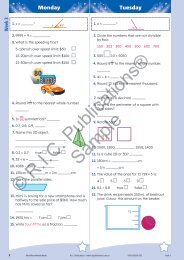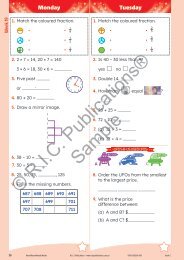PR-6171IRE Science A STEM Approach - 1st Class
You also want an ePaper? Increase the reach of your titles
YUMPU automatically turns print PDFs into web optimized ePapers that Google loves.
Energy and Forces<br />
NOW YOU SEE IT! NOW YOU HEAR IT!<br />
<strong>STEM</strong> project Project<br />
<strong>STEM</strong> Project:<br />
Teacher Notes<br />
Design and create a new product that is a combination of a sun catcher and a wind chime for the<br />
school garden—a sun chime.<br />
Estimated duration: 4 weeks<br />
1. Introduce the project<br />
• Display images of wind chimes/sun<br />
catchers on Pinterest (also linked to the first QR<br />
code on page 87 for pupils to explore<br />
individually). Ask pupils if they know what<br />
the items are called. Discuss what a sun<br />
catcher is and what a wind chime is.<br />
• Introduce the project brief on page 86 to<br />
create a sun chime for the school grounds.<br />
2. Investigate<br />
• Watch videos of wind chimes and sun<br />
catchers (linked to the QR codes on<br />
pupil page on 87): , , and . Do they make light? What<br />
source of light do they use? Do they make<br />
sound? How do they make sound?<br />
• Discuss sources of light learnt from<br />
previous lessons. What source of light<br />
do sun catchers use? Discuss what kinds<br />
of materials were used that used the<br />
sunlight. How do CDs use the sun? How<br />
does coloured glass use the sun? How do<br />
coloured beads or crystals use the sun?<br />
• Discuss what kinds of materials were used<br />
in the wind chimes and sun catchers. Why<br />
is glass used? Why is metal used? Why is<br />
wood used? What kind of sounds do they<br />
make? Pupils complete page 88.<br />
• Allow pupils time to investigate the<br />
properties of different materials before<br />
deciding which ones to use in their design.<br />
The following materials can be provided<br />
for the class: keys, washers, bottle tops,<br />
marbles, plastic beads, glass beads, craft<br />
bells, tin cans, CDs, sequins, craft gems and<br />
jewels, different-coloured plastic bottles,<br />
cellophane and pieces of metal rod. Pupils<br />
will also need fishing line or something<br />
similar to hang their sun chimes.<br />
• Other resources such as books about<br />
making sun catchers or actual examples of<br />
teacher-made or bought sun catchers can<br />
also be provided: Paper Suncatchers Kit or<br />
Origami Suncatchers: Create 20 Dazzling<br />
Stars for your Windows by Christine<br />
Gross-Loh.<br />
3. Design, plan and manage<br />
• Groups discuss ideas for different sun<br />
chime designs and the materials they want<br />
to use. Pupils design and label a plan of<br />
their design. They also make a list of the<br />
materials they would like to use and decide<br />
who will complete each component of the<br />
design. Use the plan template on page 89<br />
if required.<br />
4. Make<br />
• Groups collect resources and create their<br />
design cooperatively.<br />
5. Evaluate and refine<br />
• Pupils re-read the project brief to<br />
ensure they have included all required<br />
components and make changes if<br />
necessary.<br />
6. Communicate<br />
• Pupils create a brief video showing their<br />
design in the school grounds and how it<br />
makes sound and uses light.<br />
Viewing sample<br />
Prim-Ed Publishing – www.prim-ed.com 978-1-912760-15-2 <strong>1st</strong> <strong>Science</strong>: 85<br />
CLASS<br />
A <strong>STEM</strong> AP<strong>PR</strong>OACH


















